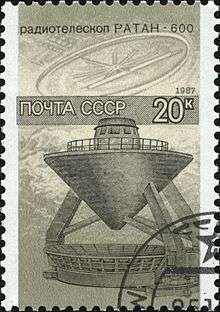RATAN-600
|
View of the observatory from a neighboring hill | |
| Organisation | Special Astrophysical Observatory of the Russian Academy of Science |
|---|---|
| Location(s) | Zelenchukskaya |
| Coordinates | 43°49′34.20″N 41°35′12.06″E / 43.8261667°N 41.5866833°ECoordinates: 43°49′34.20″N 41°35′12.06″E / 43.8261667°N 41.5866833°E |
| Wavelength | electromagnetic spectrum: (0.8 to 50 cm) (610 - 35,000 MHz) |
| Built | Opened on July 12, 1974 |
| Telescope style |
radio telescope |
| Diameter | 576 m (1,890 ft) |
| Collecting area | 12,000 square meters (130,000 sq ft) |
| Website |
www |

The RATAN-600 (Russian: РАТАН-600 – радиоастрономический телескоп Академии наук - 600, an acronym for the "Academy of Sciences Radio Telescope - 600") is a radio telescope in Zelenchukskaya, Russia. It comprises a 576 m diameter circle of rectangular radio reflectors and a set of secondary reflectors and receivers, based at an altitude of 970 m. Each of the 895 2×7.4 m reflectors can be angled to reflect incoming radio waves towards a central conical secondary mirror, or to one of five parabolic cylinders. Each secondary reflector is combined with an instrumentation cabin containing various receivers and instruments. The overall effect is that of a partially steerable antenna with a maximum resolving power of a nearly 600 m diameter dish (when using the central conical receiver), making it the world's largest diameter individual radio telescope.
Telescope
The telescope can operate in three modes:[1]
- Two-mirror system: A sector of the ring focuses waves to the cylindrical secondary mirror and further onto the receivers
- Three-mirror system: The linear plane mirror reflects the waves to the south sector of the ring, which in turn focuses on a cylindrical secondary and onto the receivers (Kraus-type periscope mirror system)
- Entire ring: For observations near the zenith, the entire ring can be used, together with the conical secondary mirror and its receivers
Simultaneous independent observations at various discrete azimuths are possible: For this, a sector of the ring is coupled with one of the secondary mirror and receiver units (which can be positioned on railway tracks) while another sector in conjunction with another secondary mirror is similarly used for an independent observation. At a wavelength of 8 cm, the effective collecting area of the entire ring is 1,000 square metres (11,000 sq ft) with a resolving power in the horizontal plane of 1 arcminute.
The RATAN-600 is primarily operated as a transit telescope, in which the rotation of the Earth is used to sweep the telescope focus across the subject of observation. Radio frequency observations can be made in the frequency band 610 MHz to 30 GHz, though primarily in the centimetric waveband, with an angular resolution of up to 2 arcseconds. Observation of the Sun at radio wavelengths, in particular of the solar corona, has been a long-standing focus of the RATAN-600's scientific programme. It has also contributed to radio observation for the SETI project. The RATAN-600 has not suffered from the persistent technical problems of the neighbouring BTA-6, and has generally been in high demand since it began operation in mid-1974.
SETI candidate signal
On 15 May 2015, at 18:01:15.65 siderial time, RATAN-600 detected a strong (0.75 Jansky) signal from the direction of HD164595. More specifically, the signal intensity rose and fell as the telescope panned past in a way that closely matched what would be expected for a distant source. Since the short wavelength (2.7 cm, or 11 GHz, in the X band) is unusual for a natural source of that power, after the researchers announced the signal in late August 2016 (in the form of a request for follow-up observations) there was a flurry of excitement that it might be a SETI candidate.[2][3] Of course, the same artificial appearance also makes a terrestrial source likely. Because the signal is in a frequency band allocated to military use, it might have originated from a secret reconnaissance satellite. After further analysis, and a failure of other observatories to corroborate the signal, the Special Astrophysical Observatory concluded that it was of probably terrestrial origin.[4]
References
- ↑ The RATAN-600 Radio Telescope - Russian Academy of Science, Special Astrophysical Observatory
- ↑ Gilster, Paul (27 August 2016). "An Interesting SETI Candidate in Hercules". Centuari Dreams blog. Retrieved 2016-08-30.
- ↑ Berger, Eric (29 August 2016). "SETI has observed a "strong" signal that may originate from a Sun-like star". Ars Technica. Retrieved 2016-08-30.
- ↑ "Monitoring of the continuum of SETI candidates with RATAN-600 (SAO RAS official comment)" (Press release). Special Astrophysical Observatory. 1 September 2016. Retrieved 2016-09-01.
In the framework of this program, an interesting radio signal at a wavelength of 2.7 cm was detected in the direction of one of the objects (star system HD164595 in Hercules) in 2015. Subsequent processing and analysis of the signal revealed its most probable terrestrial origin.
External links
| Wikimedia Commons has media related to RATAN-600. |
- SAO homepage (English and Russian)
- Satellite photo of RATAN-600 on Google Maps, centered on the centre of the telescope
